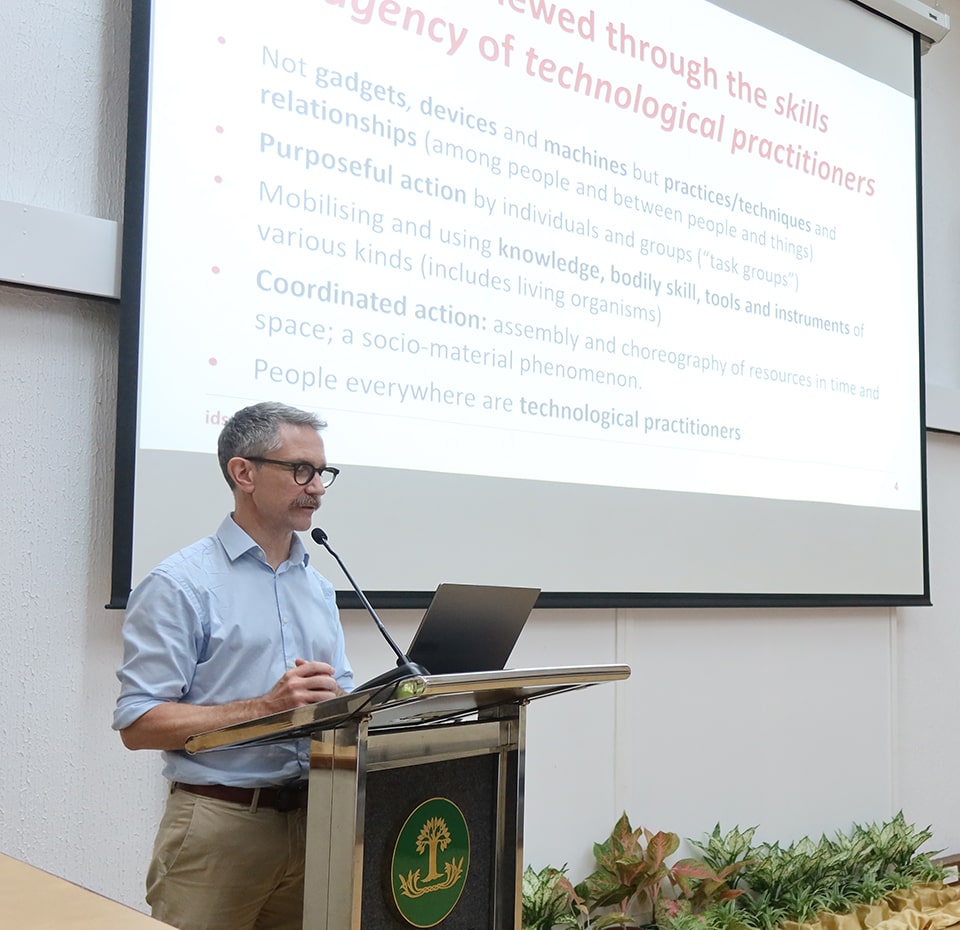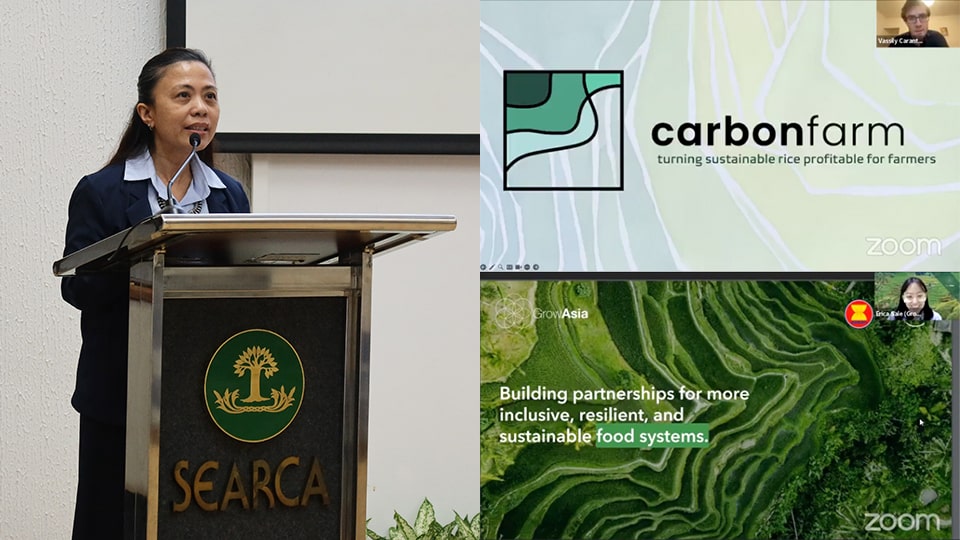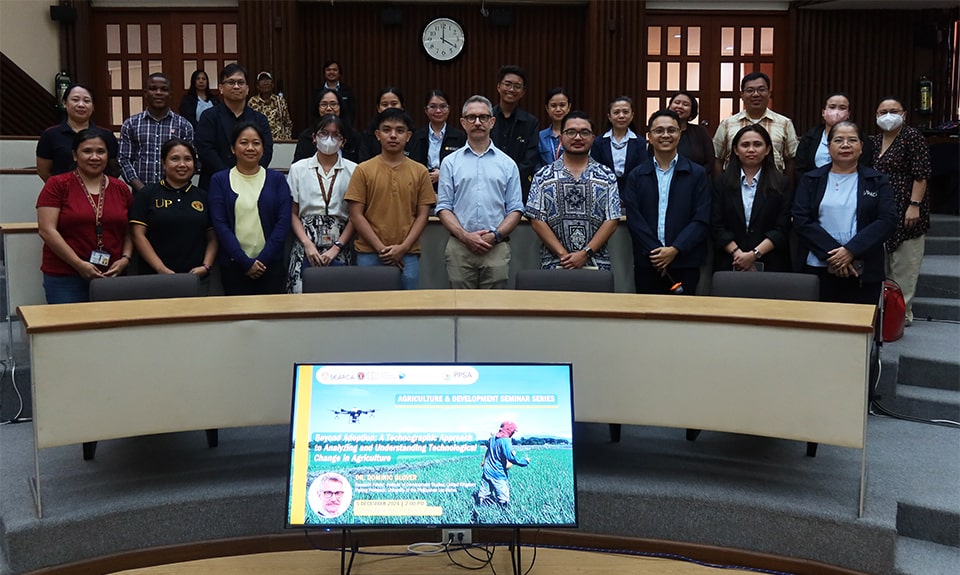The Southeast Asian Regional Center for Graduate Study and Research in Agriculture (SEARCA) hosted Dr. Dominic Glover under its Agriculture and Development Seminar Series (ADSS) on 5 December at the Drilon Hall, SEARCA Headquarters. Dr. Glover introduced a groundbreaking approach to understanding technological change in agriculture, moving beyond the traditional concept of adoption. Titled Beyond Adaptation: A Technographic Approach to Analyzing and Understanding Technological Change in Agriculture, Dr. Glover presented the PEDRO framework (Proposition, Encounter, Disposition, Response, and Outcome) that highlights the diverse actors and varying forms of agency involved in technological change, focusing on the role of technological practitioners who are directly engaged in the creation and implementation processes. Dr. Glover is a Research Fellow at the Institute of Development Studies in the United Kingdom and a Visiting Professor at the University of the Philippines Los Baños (UPLB).
Dr. Glover explained that the PEDRO framework was developed in response to significant shortcomings in the widely used concept of adoption as a measure of technological change in agriculture. He shared that the idea of adoption is too linear, too binary, and overly simplistic. "Empirically, what we observe is often not a replication of a standard design but a range of variation and adaptation," he added. He also pointed out that evaluation studies often fail to specify observable indicators that signify adoption, relying instead on visible artifacts as symbols of technological change.
 Dr. Glover presents the PEDRO framework, a new approach to understanding agricultural technological change, during SEARCA's ADSS.
Dr. Glover presents the PEDRO framework, a new approach to understanding agricultural technological change, during SEARCA's ADSS.
To address these limitations, Dr. Glover and his co-authors broke down technological change or adoption into interrelated components. The first component of the framework is propositions, which could be an initial idea, a concept, or a suggestion that farmers could try to achieve new or modified outcomes. The proposition has three essential aspects: first, it includes a variety of biophysical resources; second, it contains methods, techniques, and practices; and third, a proposed mode of engagement in agricultural production.
The second component of the framework is encounters, which is the occasion or arena where the proposition is brought to attention. Dr. Glover explained that encounters may be deliberately orchestrated by an external agency, such as a development program, extension officer, a farmer field school, or even a demonstration plot. Moreover, encounters may emerge in unplanned ways through the agency of a farmer or laborer. Unplanned ways include observing a neighbor's activities, exposure to advertising, social media, and the like.
The third component is dispositions. "What we mean here is, essentially, how receptive a particular group might be to taking up a proposition and whether they find the encounter congenial or not," Dr. Glover said. He explained that there are different dispositions for different actors. A proposition could be perceived differently by a male-headed household from a female-headed household, a younger person from an older person, or a person with a large amount of land from a person with very little land. These dispositions are where potential modifications can be made.
The fourth component is responses. Dr. Glover pointed out that the PEDRO framework is designed to capture a spectrum of potential responses, not just adoption, non-adoption, or possibly disadoption. The categories of responses may include ignore, explore, deplore, and adore. Examples of responses are "Not of interest to me. Thank you very much." for ignore; "Okay, that could be interesting. I'm going to have a look." for explore; "We are opposed to this technology. We don't like it at all." for deplore; and "This is fantastic. I am going all in." for adore. Dr. Glover stressed that "the thin concept of adoption is simply inadequate to capture the range of responses that could emerge within these types."
Lastly, the fifth component is outcomes, which are likely diverse and heterogeneous for different people, groups, and localities. He explained that "implications of a technological design might be different for a young woman over an older man, a person who has completed 12 years of education over someone who dropped out of school, or a person with farm assets over someone without land."
In closing, Dr. Glover highlighted that the PEDRO framework is not just a theoretical concept, but a practical tool that could be used to analyze and evaluate technological change. It can be applied both ex ante (i.e., to inform the design and guide implementation) and ex post (i.e., to inform the evaluation). "It can also be used to study the ramifications, rather than the impacts, of a technological change intervention in nondeterministic ways, with fewer preconceptions about what you think the technology is for, how you think it ought to be used, by whom, and for what. Instead, see what people do with the ideas and materials you introduce," he added.
Serving as reactors during the ADSS were Mr. Vassily Carantino of CarbonFarm, Ms. Erica Kristel Sale of Grow Asia, and Ms. Lichelle Dara Carlos of SEARCA's Emerging Innovation for Growth Department. They shared insights on how the PEDRO framework can be contextualized to their projects and programs on climate-smart innovations in Southeast Asia, providing practical applications and real-world examples of the framework's use.
 Ms. Carlos of SEARCA (left), Mr. Carantino of CarbonFarm (top right), and Ms. Sale of Grow Asia (bottom right) introduced their respective organizations, including their programs and projects.
Ms. Carlos of SEARCA (left), Mr. Carantino of CarbonFarm (top right), and Ms. Sale of Grow Asia (bottom right) introduced their respective organizations, including their programs and projects.
The event was co-organized by SEARCA, the UPLB College of Development Communication - Department of Science Communication, and the Philippines Partnership for Sustainable Agriculture (PPSA).
Check this out for more details of his ADSS presentation: https://www.searca.org/events/seminar/2024/beyond-adaptation-technographic-approach-analyzing-understanding-technological-change-agriculture
 Participants of this ADSS came from SEARCA, UPLB, Benguet State University, and other institutions from the Los Baños Science Community.
Participants of this ADSS came from SEARCA, UPLB, Benguet State University, and other institutions from the Los Baños Science Community.